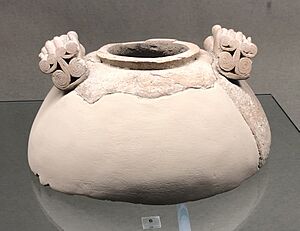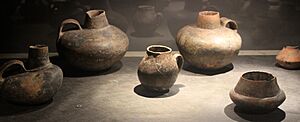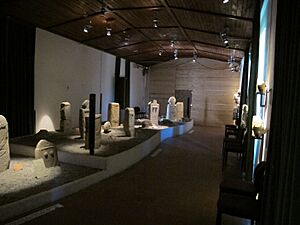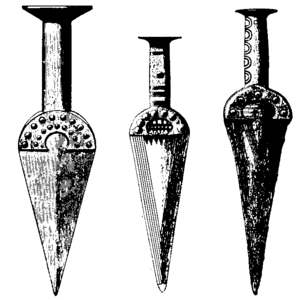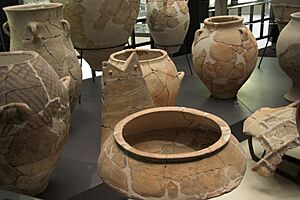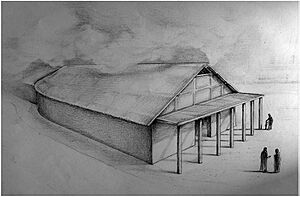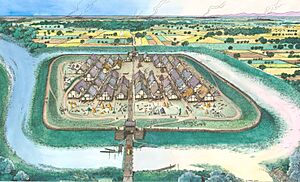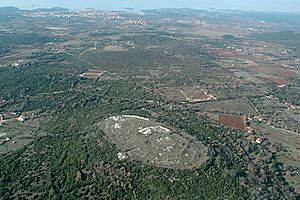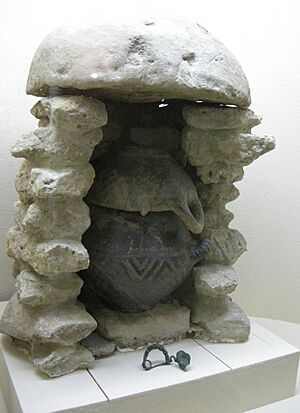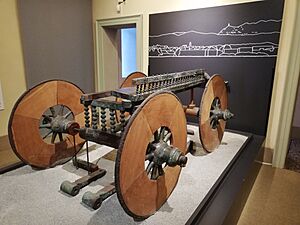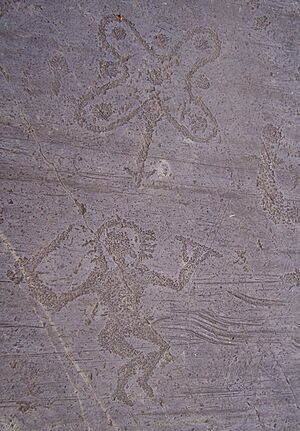Prehistoric Italy facts for kids
The prehistory of Italy is the story of how people lived in the Italian land long before written records began. It started in the Paleolithic period, when the first humans arrived, and ended in the Iron Age, when writing first appeared in Italy.
Contents
Ancient Stone Age (Paleolithic)
In ancient times, the Italian Peninsula looked quite different from today. During ice ages, for example, the sea level was much lower. This meant that islands like Elba and Sicily were connected to the mainland! The Adriatic Sea was also smaller, starting where the Gargano Peninsula is now. The area that is now underwater up to Venice was a fertile plain with a wet climate.
The first known human relatives arrived about 850,000 years ago at a place called Monte Poggiolo.
Evidence of Homo neanderthalensis (Neanderthals) has been found in Italy from around 50,000 years ago. There are about twenty such sites. Important ones include Grotta Guattari near San Felice Circeo and the grotta di Fumane near province of Verona.
Homo sapiens sapiens (modern humans like us!) appeared during the later part of the Stone Age. The earliest site in Italy is Riparo Mochi, dating back 48,000 years. In 2011, scientists found baby teeth from the Grotta del Cavallo that were 43,000 to 45,000 years old, showing early modern human presence.
The oldest complete human skeleton found in Sardinia, named Amsicora, was discovered in 2011. Scientists believe it is about 8,500 years old, from the time between the Middle Stone Age (Mesolithic) and New Stone Age (Neolithic).
New Stone Age (Neolithic)

Cardium pottery is a special type of pottery from the New Stone Age. It gets its name because people decorated the clay by pressing the shell of a Cardium edulis (a type of seashell) into it. Sometimes, other sharp objects like nails or combs were used, so it's also called Impressed Ware.
This pottery style is found across Italy, especially along the Ligurian coast. It gives its name to a major culture of the Mediterranean Neolithic period, which spread from the Adriatic Sea all the way to the Atlantic coasts of Portugal and down to Morocco.
Since the Late Neolithic, areas like Aosta Valley, Piedmont, Liguria, Tuscany, and especially Sardinia became part of the widespread Megalithic (large stone) movement in Western Europe. Later, in the Bronze Age, large stone structures were also built in Latium, Puglia, and Sicily. Around 3,000 BC, Sicily adopted some cultural ideas from Sardinia, including small dolmen-shaped structures (ancient tombs made of large stones) that spread across the Mediterranean.
Copper Age
The Copper Age arrived very early in Italy. Copper began to be mined in Liguria around 3700 BC, making the Libiola and Monte Loreto mines the oldest copper mines in the western Mediterranean. The Remedello, Rinaldone, and Gaudo cultures were important late Neolithic cultures in Italy. Their traces are mainly found in Lombardy, Tuscany, Latium, and Campania. They are sometimes called Eneolithic cultures because they used early copper tools. Other important cultures of this period include the Laterza culture in Apulia and Basilicata, the Abealzu-Filigosa culture in Sardinia, and the Serraferlicchio culture in Sicily.
The first Statue menhirs (tall, carved stones, often showing weapons) were set up by people in northern Italy and Sardinia during this time. This tradition of carving statues continued into the Bronze and even Iron Ages in some areas.
The Bell Beaker culture marks the time when the Copper Age transitioned into the early Bronze Age.
-
A ceramic pot from the Bell Beaker culture
Bronze Age
The Italian Bronze Age is divided into four main periods:
| The Early Bronze Age | 2300–1700 B.C |
| The Middle Bronze Age | 1700–1350 B.C |
| The Recent Bronze Age | 1350–1150 B.C |
| The Final Bronze Age | 1150–950 B.C |
The Early Bronze Age saw the start of a new culture in Northern Italy called the Polada culture. Polada settlements were often found in wet areas, like around large lakes and hills near the Alps. In Southern Italy, the Palma Campania culture spread, with places like Toppo Daguzzo and La Starza becoming important centers.
The Middle Bronze Age, known as the Apennine Bronze Age in Central and Southern Italy, was a time when people built settlements both in lowlands and on hills. We can see signs of social differences (like some groups being more important than others) from how people were buried. For example, at Toppo Daguzzo, a two-level grave was found. The top level had ten broken skeletons with no grave goods, while the lower level had eleven burials with valuable items like bronze weapons for men and beads for women. In Northern Italy, the Terramare culture was important during this period.
The Recent Bronze Age, called the Sub-Apennine period in Central Italy, was a time when people moved their settlements to places that were easier to defend. During this period, some cities, like those in Latium and Tuscany, became more important than others.
The Final Bronze Age is when most of the Italian peninsula was united under the Proto-Villanovan culture. Most Proto-Villanovan cemeteries were small, but Pianello di Genga was an exception, with over 500 burials, showing it was used by different communities for two centuries.
Polada Culture
The Polada culture (named after a place near Brescia) was a cultural group that spread from eastern Lombardy and Veneto to Emilia and Romagna in the first half of the 2nd millennium BC. It might have started when new people arrived from Switzerland and Southern Germany.
Their settlements were usually made of stilt houses (houses built on poles above water or wet ground). They farmed, raised animals, hunted, and fished. They also worked with copper and bronze, making axes, daggers, and pins. Their pottery was rough and dark.
Nuragic Civilization
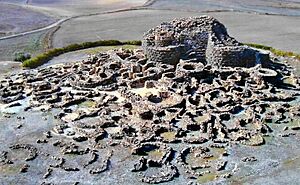

The Nuragic civilization was located in Sardinia (and parts of southern Corsica). It lasted from the early Bronze Age (18th century B.C.) until the island became Romanized around the 2nd century A.D. This civilization grew from earlier cultures that built dolmens (stone tombs), menhirs (tall standing stones), and over 2,400 Domus de Janas (rock-cut tombs).
The civilization is named after its unique stone towers called Nuraghe. These towers are considered the best-preserved and largest large stone remains in Europe. Their exact purpose is still debated; most experts think they were fortresses, while others believe they were temples.
The ancient Sardinians were a people of warriors and sailors. They traded a lot with other Mediterranean peoples. We know this because many items found in the nuraghe towers came from far away, like amber from the Baltic Sea, small bronze figures of African animals, and weapons and pottery from the Eastern Mediterranean. Some historians think that the ancient Sardinians, or at least some of them, might have been the Sherden, one of the "Sea Peoples" who attacked ancient Egypt and other parts of the eastern Mediterranean.
Other special parts of the Sardinian civilization include temples called "Holy wells" for water worship, Giants' graves (large tombs), and many Nuragic bronze statuettes (small bronze statues). These statuettes have even been found in Etruscan tombs, suggesting a strong connection between the two peoples. Another important discovery is the Giants of Mont'e Prama, which are possibly the oldest human-shaped statues in the western Mediterranean.
Sicily
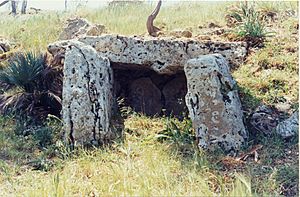
Some of the most important cultures in Sicily during the Bronze Age were the Castelluccio (Early Bronze Age) and Thapsos (Middle Bronze Age). Both started in the southeastern part of the island. These cultures show clear influences from the Aegean Sea, where the Helladic civilization (like ancient Greece) was thriving.
Small stone monuments from this time, used as tombs, have been found almost everywhere, both inland and along the coasts. The Bell Beaker culture, which came from Western Europe, is found in sites on Sicily's northwestern and southwestern coasts. In the late Bronze Age, there are signs in northeastern Sicily of cultural mixing with people from the mainland, leading to the appearance of the Proto-Villanovan culture at Milazzo, possibly linked to the arrival of the Sicels.
The nearby Aeolian Islands also saw the development of the Capo Graziano and Milazzo cultures in the Bronze Age, followed by the Ausonio culture.
Palma Campania Culture
The Palma Campania culture appeared at the end of the third millennium BC and represents the Early Bronze Age in Campania. It is named after the town of Palma Campania, where the first discoveries were made.
Many villages of this culture were buried under volcanic ash after an eruption of Mount Vesuvius around 2000 BC or shortly after.
Apennine Culture
The Apennine culture was a group of related cultures in central and southern Italy that existed throughout the Bronze Age. In its more specific meaning, it refers to the later part of the Middle Bronze Age (15th and 14th centuries BCE).
The people of the Apennine culture were partly cattle herders, moving their animals across the mountains of central Italy. We know this because their pottery has been found in the oldest layers of occupation, even on the Capitoline Hill in Rome. They often lived in small villages located in places that were easy to defend. When herders traveled between summer pastures, they built temporary camps or lived in caves. However, they didn't just live in the hills or only herd cattle. Sites like Coppa Nevigata, a well-defended coastal settlement, show that they had various ways of getting food and even advanced industries like making dyes.
Terramare Culture
The Terramare was a culture of the Middle and Recent Bronze Age, existing between the 16th and 12th centuries B.C. in the Pianura Padana (Po Valley), especially along the Panaro river between Modena and Bologna. Their total population might have reached over 120,000 people at the start of the Recent Bronze Age. In the early period, they lived in villages with about 130 people in wooden stilt houses. These villages were square-shaped, built on land but usually near a stream, with roads crossing at right angles. Over time, these settlements grew into larger towns of up to 15-20 hectares (about 1500-2000 people) surrounded by smaller villages. Especially in the later period, almost all settlements were fortified.
Around the 12th century BC, the Terramare system collapsed. The settlements were abandoned, and the people moved south, where they mixed with the Apennine peoples. The movement of these people from the Po Valley to the south might have led to the formation of the Tyrrhenian culture, which eventually became the historic Etruscans.
Castellieri Culture
The Castellieri culture developed in Istria during the Early and Middle Bronze Age, and later spread into Friuli, modern Venezia Giulia, Dalmatia, and nearby areas. It lasted for over a thousand years, from the 15th century BC until the Roman conquest in the third century BC. It is named after the fortified towns (Castellieri) that were typical of this culture.
The origin of the Castellieri people is not certain, but they were likely a pre-Indo-European group who arrived by sea. The first Castellieri were built along the Istrian coast and show similar large stone walls (Cyclopean masonry) to those used by the Mycenaean civilization at the time. The best-studied Castelliere in Istria is Monkodonja near Rovinj.
The Castellieri were fortified settlements, usually located on hills or mountains, or more rarely (like in Friuli) on plains. They had one or more circular or oval walls in Istria and Venezia Giulia, or square walls in Friuli, with the living area inside.
Hundreds of Castellieri have been found in Istria, Friuli, and Venezia Giulia. The largest castelliere was probably Nesactium, in southern Istria, near Pula.
Canegrate Culture
The Canegrate culture developed from the mid-Bronze Age (13th century BC) until the Iron Age in the western Pianura Padana (Po Valley), in what is now western Lombardy, eastern Piedmont, and Ticino. It is named after the town of Canegrate, where about fifty tombs with pottery and metal objects were found in the 20th century. This culture represents the first wave of proto-Celtic people from the northwestern Alps who moved into the western Po Valley. They brought a new way of burying the dead: cremation (burning the body), which replaced inhumation (burying the body whole).
Canegrate pottery is very similar to pottery found from the same period north of the Alps (in France and Switzerland). The people of this culture have been described as warriors who came down to the Po Valley from the Swiss Alps.
Proto-Villanovan Culture
This was a culture from the end of the Bronze Age (12th-10th century BC) that was widespread across much of the Italian peninsula and northeastern Sicily (including the Aeolian Islands). It was known for its funeral ritual of incineration. The ashes of the dead were placed in double-cone shaped urns decorated with geometric patterns. Their settlements were often built on hilltops and protected by stone walls.
Iron Age
Villanova Culture
This Iron Age civilization is named after a place called Villanova near Bologna, where a cemetery was discovered in the 1850s. It followed the Proto-Villanovan culture during the Iron Age in Tuscany and northern Lazio, and also spread to parts of Romagna, Campania, and Marche.
The main feature of the Villanovans was their cremation burials. The ashes of the dead were placed in special double-cone shaped urns and then buried. This burial style connects the Villanovan culture to the Central European Urnfield culture and Hallstatt culture.
The Villanovans initially focused on farming and raising animals, with a simple social structure. Later, as they developed skilled crafts like metalworking and pottery, they gathered more wealth, which led to different social classes appearing.
Latial Culture
The Latial culture existed in ancient Old Latium. This Iron Age culture appeared around the same time that people speaking Old Latin arrived in the region. It likely represents a stage in the development of the Latin tribe, during the time of the kings of Alba Longa and the founding of the Roman Kingdom.
Este Culture
The Este culture (also called Atestine culture) was an Iron Age culture that existed from the late Italian Bronze Age (10th-9th century BC) until the Roman period (1st century BC). It was located in the modern region of Veneto in Italy and developed from the earlier Proto-Villanovan culture. It is also known as the "civilization of situlas" (special bronze buckets).
Golasecca Culture
The Golasecca culture developed starting from the early Iron Age in the northwestern Po plain. It is named after Golasecca, a place near the Ticino river where the first discoveries were made in the early 19th century. Remains of the Golasecca culture cover an area of about 20,000 square kilometers south of the Alps, dating from the 9th to the 4th century BC.
Their origins can be directly traced back to the Canegrate culture and the Proto-Golasecca culture (12th–10th centuries BC). The Golasecca culture traded with the Etruscans and the Hallstatt culture to the north. Later, they traded with the Greek world (exchanging oil, wine, bronze objects, and pottery) and Northern Europe (getting tin and amber from the Baltic coast).
In a Golasecca culture tomb in Pombia, the oldest known remains of common hop beer in the world were found!
The Camuni
The Camuni were an ancient people whose origin is uncertain. They lived in Val Camonica – in what is now northern Lombardy – during the Iron Age. However, human groups of hunters, shepherds, and farmers are known to have lived in the area since the Neolithic.
They became very powerful during the Iron Age because there were many iron mills in Val Camonica. Their historical importance, however, comes mostly from the amazing legacy of carved rocks they left behind. There are about 300,000 of these carvings, dating from the Paleolithic to the Middle Ages.
Pre-Roman Period
Among the many peoples of pre-Roman Italy, the most famous were the Etruscans. Starting from the 8th century BC, they created a very advanced civilization that greatly influenced Rome and the Latin world. The origins of this non-Indo-European people are not fully known. They first settled on the Tyrrhenian coast of central Italy and later spread to northern Italy (especially Emilia) and Campania.
Other peoples living in northern Italy included the Ligurians (an Indo-European people in what is now Liguria, southern Piedmont, and the southern French coast), the Lepontii, Insubres, Orobii, and other Celtic tribes in Piedmont and Lombardy, and the Veneti in northeastern Italy.
In the peninsula, alongside the Etruscans, lived many tribes, mostly of Indo-European origin: the Umbri in Umbria and northern Abruzzo; the Latins, who created the Roman civilization; Sabellians, Falisci, Volsci, and Aequi in Latium; Piceni in the Marche and northeast Abruzzo; Samnites in southern Abruzzo, Molise, and Campania; Daunians, Messapii, and Peucetii (who formed the Apulian or Iapygian group) in Apulia; Lucani and Bruttii in the southern tip of the peninsula. In Sicily lived the Sicels, Elymians, and Sicani, while Sardinia was still home to the Nuragic peoples.
Later, other peoples settled in Italy, living alongside the existing inhabitants. These included new tribes of Celts in the north (like the Senones and Boii), the Greeks in coastal southern Italy, and the Phoenicians in parts of Sicily and Sardinia.
Images for kids
See also


